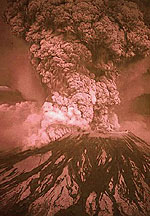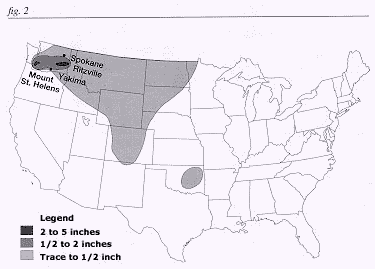 |


|
Lesson 3 Activity 1: Tracking an Ash Cloud
- 15-minute demonstration
- 45-minute work session
- Students observe a demonstration of a "dust box" to help them understand that some volcanic ash (tephra) may be difficult to see. In a work session, they will then use the equation, D = RxT (distance is equal to the rate of speed times the time of travel) to calculate the time it took volcanic ash erupted into the atmosphere to travel to different parts of the United States following the May 18, 1980, eruption of Mount St. Helens.
Key teaching points
- Explosive volcanoes can erupt large quantities of tephra, gases, and aerosols into the atmosphere.
- The smallest of these particles are suspended in the atmosphere and are sometimes carried by wind great distances from the immediate site of an eruption. Some of these particles are too small to see.
Materials
Demonstration
- Large cardboard box such as a photocopy paper box
- Black construction paper, dark cloth bed sheet, or black spray paint
- Glue, tape, or staples
- Scissors
- Pencil or pen
- Flashlight
- Two erasers with chalk dust
Work Session
- Activity Sheets 3.1 a - b
- Atlas
- Colored pens or pencils
- Calculators (optional)
Procedures
Preparation: Assembling the "dust box" (fig. 3)
 |
- Remove the flaps from one side of the box.
- Line the interior of the box with black construction paper or a dark sheet, or spray paint it black.
- On one side, cut a hole the same size as the lamp end of the flashlight.
|
Introduction
 Use the photograph on the left (click picture to see the larger version) and point out the column of ash rising above Mount St. Helens. Remind students that in Lesson 1 they learned that explosive volcanoes like Mount St. Helens erupt rock and lava fragments, gases, and aerosols into the atmosphere. The rock fragments, which are called tephra, can range in size from car-sized boulders to ash or dust that is so small it is invisible to the naked eye.
Use the photograph on the left (click picture to see the larger version) and point out the column of ash rising above Mount St. Helens. Remind students that in Lesson 1 they learned that explosive volcanoes like Mount St. Helens erupt rock and lava fragments, gases, and aerosols into the atmosphere. The rock fragments, which are called tephra, can range in size from car-sized boulders to ash or dust that is so small it is invisible to the naked eye.
Demonstrations
- With the lights on, beat two erasers together inside of the "dust box."
- Ask students to raise their hands when they can no longer see any "dust" in the air. When the last student has raised his or her hand, turn on the flashlight. Ask students to put their hands down if they now see dust.
Work Session
- Discuss the photographs and captions in the atmosphere section of the poster (poster figs.12, 13, 14). Remind students of the "dust box" demonstration. Like chalk dust, the smallest volcanic particles stay suspended in the atmosphere. Once in the atmosphere, they can be carried by wind great distances from the volcano. (fig. 2)
 |
| Fig 2: this map shows the distribution of ash fallout from the May 18, 1980, eruption. |
- Some of these particles are so small that they form invisible clouds, which are particularly dangerous to airplanes that unknowingly encounter volcanic ash clouds. Volcanic ash sucked into jet engines can cause the engines to stall, as the following story illustrates:
Following the 1989 eruption of Mount Redoubt in Alaska, a Boeing 747 aircraft lost power in all four of its engines after flying into a volcanic ash cloud. Finally after losing 4,267 meters (14,000 feet) in altitude the pilot was able to restart the engines. The airliner landed safely, but the damage to the aircraft has been estimated to exceed $80 million. Because of the potential hazard posed by ash clouds to aircraft, air traffic controllers need to issue warnings to aircraft flying in the air space they monitor.
- Tell the students that they are air traffic controllers. They have just received word that Mount St. Helens has had a major eruption. They should stand by to receive critical data so that they can calculate when airborne ash will reach the air space they monitor. Discuss with the class the type of data they will need to gather, such as
- the time of the eruption,
- the wind direction,
- the rate of speed the airborne tephra is traveling, and
- how far their city is located from the eruption.
- Divide the class into teams of air traffic controllers for each of the following locations:
- Great Falls, Mont.
- Rapid City, S. Dak.
- Madison, Wis.
- Minneapolis, Minn.
- Chicago, Ill.
- Detroit, Mich.
- Pittsburgh, Pa.
- Boston, Mass.
- On their activity sheet, each team will use the data to calculate the time the ash is expected to arrive in the air space they monitor. (The ash cloud is moving at a rate of 96 kilometers per hour.)
- Distribute the Activity Sheets.
- Before students begin, review with the class the formula (D=RxT). Demonstrate how to use the formula to calculate both rate and time.

- As a homework assignment, ask each student to calculate the time it took the ash cloud to circle the Earth. The Earth is 40,000 kilometers (20,500 miles) at the Equator.
Activity Sheet 1
Answers |
|
City
Great Falls
Rapid City
Madison
Minneapolis
Chicago
Detroit
Pittsburgh
Boston
|
Kilometers
850
1,450
2,500
2,100
2,700
3,050
3,400
3,900
|
Hours
9
16
27
23
29
33
37
42
|
|
Introduction |
Teacher's Guide & Lessons |
Download PDF |
Main
|
|
|
 |
|